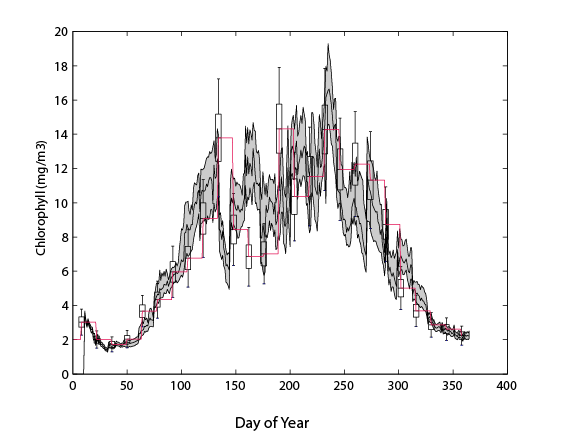Trevor Page, Paul Smith, Keith Beven (Lancaster University)
Ian Jones, Alex Elliott, Stephen Maberly (CEH)
DOWNLOAD
THE CHALLENGE
Algal blooms are a significant problem for water resources worldwide, estimated to cost more than £50 million per year in the UK. Some species of algae (e.g. cyanobacteria; more commonly known as blue-green algae) can produce toxins that can be harmful to people and animals, making waterbodies unsafe for recreational activities and as a drinking water resource. These harmful algal blooms most often occur in nutrient-rich waters, particularly during warm, calm weather, and are predicted to increase under a changing climate. Closure of recreational waters and water resource mitigation strategies are inconvenient and costly. It is therefore an advantage to have an early-warning system to be able to implement the most cost-effective management strategies.
WHAT WAS ACHIEVED
A real-time algal bloom forecasting system was developed1,2,3 providing up to 10 day ahead forecasts. The system used high-frequency in-lake observations, ECMWF weather forecasts and a computer model to provide estimates of how a lake algal community is likely to change over the forecast period. Importantly the computer model includes species-level algal estimates as only specific species of algae produce toxins. This work demonstrated that algal forecasting is feasible, that real-time high frequency data are critical to improve forecasting accuracy and in reducing uncertainty. The requirement and cost-effectiveness of such a system has been assessed under a NERC Pathfinder project1 which identified that there is currently a move within the water industry towards the use of real-time data to inform decision making, and that the algal forecasting system could provide another step towards development of this “intelligent network”. The tool was shown to be cost effective for specific “problem” water bodies, and that cost-effectiveness would be far higher if wider societal benefits, such as recreational access, knock-on effects on local businesses and willingness to pay versus willingness to accept algal blooms, were taken into account.
HOW WE DID IT
The system (Figure 1) development was based around the modification of an algal community model PROTECH (Reynolds et al., 2001) to allow it to utilise high frequency data, collected from buoys deployed onto lakes across the UK2, to improve forecasts. The physical (i.e. non-biological) part of the model was simplified as a way of increasing its speed in order to allow better representation of forecast uncertainties. This simplification also allowed better utilization of real-time buoy data whilst retaining the important biological parts necessary to provide species level forecasts. The weather forecasts used to drive the model required modification for specific lakes (a “downscaling” procedure) and rainfall forecasts were used to drive a very simple hydrological model which estimated what the inflows to the lake would be for the forecast period. Inflows were associated with nutrient inputs to the lake which are a critical and particularly challenging part of the forecasting jigsaw.

 Figure 1 (a) Forecasting system components; (b) example of concatenated 10 day ahead forecast
Figure 1 (a) Forecasting system components; (b) example of concatenated 10 day ahead forecast
REFERENCES
1 NERC Pathfinder Grant NE/N004817/1
2 NERC UKLEON project (http://www.ecn.ac.uk/what-we-do/science/projects/ukleon)
3 NERC, PURE, CREDIBLE (Consortium on Risk in the Environment: Diagnostics, Integration, Benchmarking, Learning and Elicitation) Project.